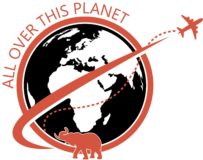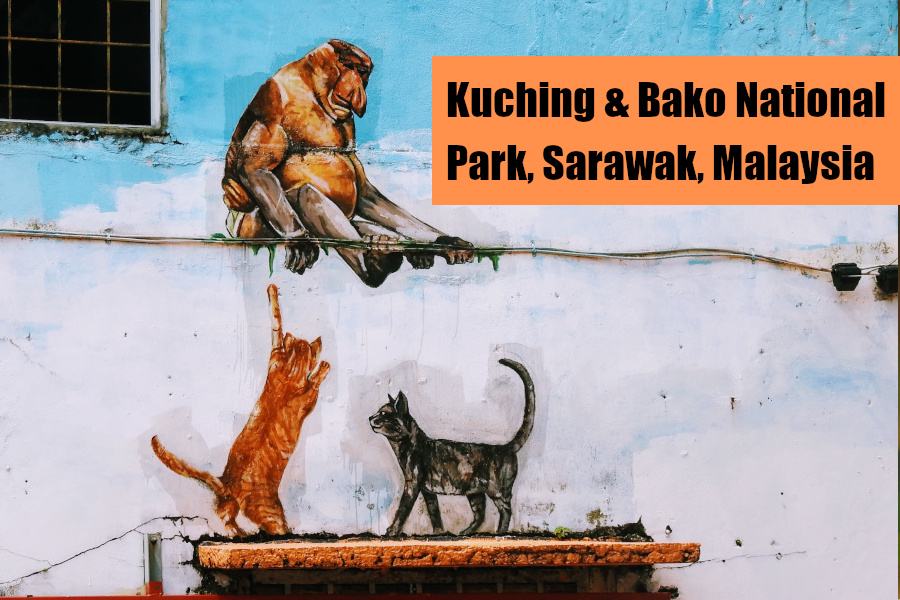We left Zambia behind and entered Zimbabwe on day 37 of our overland tour. After crossing the border we drove to the capital city of Harare. We arrived on a Sunday afternoon so most of the shops in town were closed except for the grocery store. We had planned to camp at It’s a Small World Backpacker’s Lodge, which is located right inside the city limits within walking distance to shops and restaurants. When we arrived another overland truck had arrived before us and claimed all the camping space. Instead of driving to the alternative campground, which was quite far away, we all agreed to pay a little extra and upgrade to their hotel rooms instead of camping for the night, a plan I gladly agreed to. After we had our usual group dinner together, Rob and I decided to check out a music club just around the corner from the hotel with our trip leader and a fellow traveler. The club was pretty lively for a Sunday night and had live music, which included a few bands mostly playing cover songs of popular American music (not the African music we were hoping for but it was fun). Harare seems to have some great night life and it was nice to get out and experience that a little bit.
In the morning we left Harare and drove to Masvingo, where we camped for a night at Norma Jean’s Lakeview Resort. This campsite had a stunning setting with lake views and modern bathrooms with hot showers.
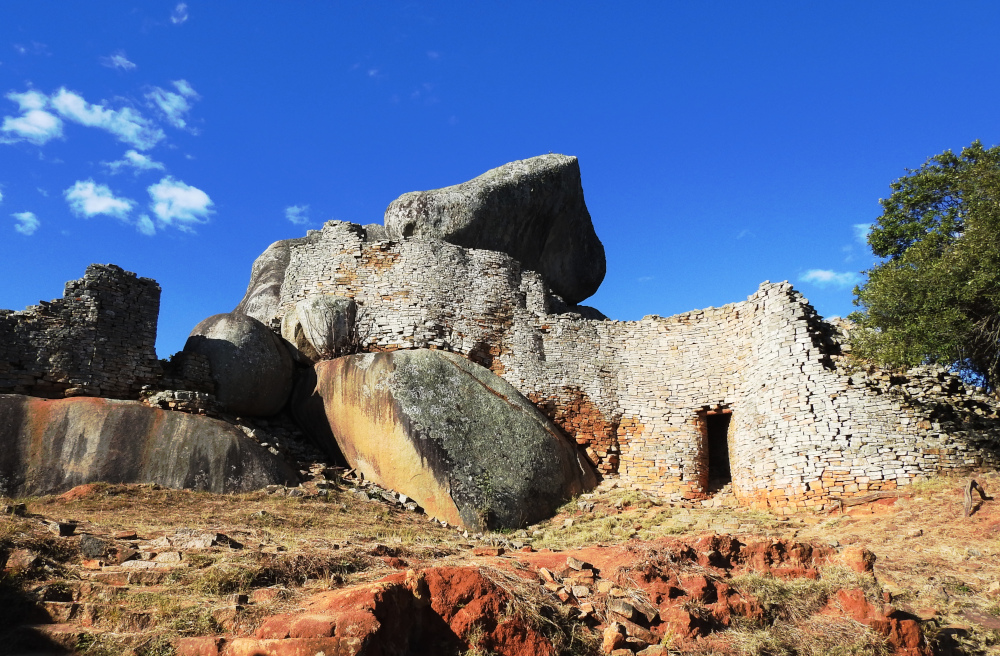
In the afternoon we went on a guided tour of the Great Zimbabwe Ruins, a UNESCO World Heritage site. The country’s official name was changed to Zimbabwe after these ruins in 1980 when the country gained independence from Britain. The ruins were constructed between the 11th and 15th centuries and include impressive curved stonewalls, with many that still stand today. The area has unusually shaped rock formations and boulders and the stonewalls were built to connect seamlessly with the natural environment. The curved walls are architecturally interesting but also served as protection from potential intruders. We were able to sit in a small cave high up on the mountain that kings used to sit in and shout out across the valley to summon a few of their many (often hundred plus) wives. We also visited the small on-site museum where some of the famous soapstone Zimbabwe birds are on display.
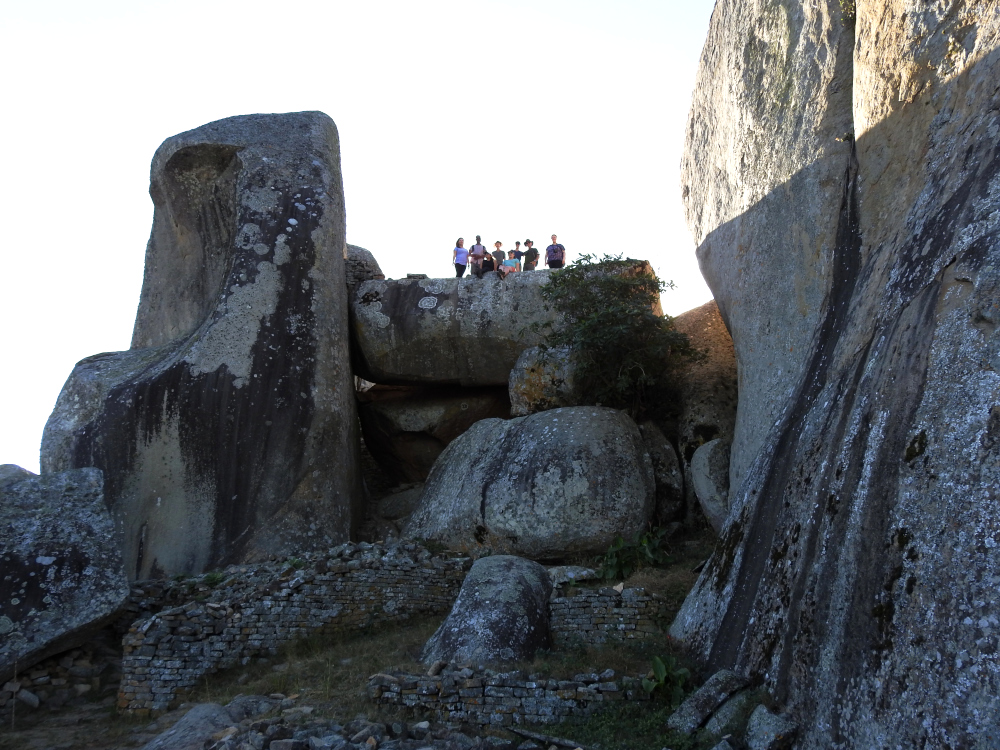
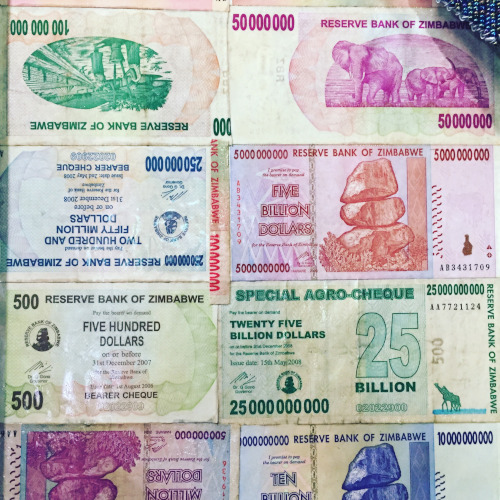
Zimbabwe has had its share of economic challenges over the years. Due to their ongoing currency crisis, we were advised to bring enough US dollars with us into the country to cover any spending money we might need while in Zimbabwe. We were told local currency can be hard for foreigners to obtain and most places prefer the US dollar. You can buy old Zimbabwe currency from the days of hyperinflation on the street as souvenirs. At one time they even had a 100 trillion dollar note in circulation.
On our second day in the country the Zimbabwe government made a surprise announcement that all foreign currencies, including the US dollar, were now illegal to use for local transactions (read more about that here if you like). We only found this out because we happened to see a newspaper in the grocery store. We spent two nights in the town of Bulawayo and when we tried to buy groceries they would not accept our US dollars and also would not take our credit card. Since we had no way to pay we had to just leave our items at the store. We were told credit card fees on international cards can be as high as 20% for retailers in Zimbabwe so many have elected not to accept them.
Our campsite in Bulawayo was set up on a nice local family’s property and from them we learned that due to shortages, their electricity (along with everyone else’s in the area) is completely turned off two days a week so they have no power and very little water pressure during that time. We were not able to have a warm shower with decent pressure while staying in Bulawayo. While driving around town we also noticed very long lines of people waiting to get fuel at the gas stations. We ate lunch at a lovely local restaurant in downtown Bulawayo and they agreed to take US dollars from us for payment but they asked us go in the back of the restaurant out of sight from all the other customers to pay. They were kind to let us pay this way and I think they could have run into some trouble for doing so if the wrong person witnessed the transaction. Apparently no one knew this drastic change in currency policy was coming at this exact moment in time so it seemed to put small businesses in a tough spot giving them little help with the transition.
While in Bulawayo we were treated to an amazing full day tour of the Matobo National Park by Kurt with African Wanderer Safaris. The morning started with us accompanying Kurt as he tracked rhinos inside the park. Kurt drove us in a safari vehicle to a spot where he saw rhino tracks then pulled off the road and set off on foot to go look for the rhinos. After walking a short way, we were treated to the sight of a mother and baby rhino together. With Kurt guiding us, we were able to walk within 20 feet of them and watch them for a good thirty minutes, being careful to be quiet and not to disturb them in any way. It was incredible to be so close to these magnificent animals and observe the mother and baby together.
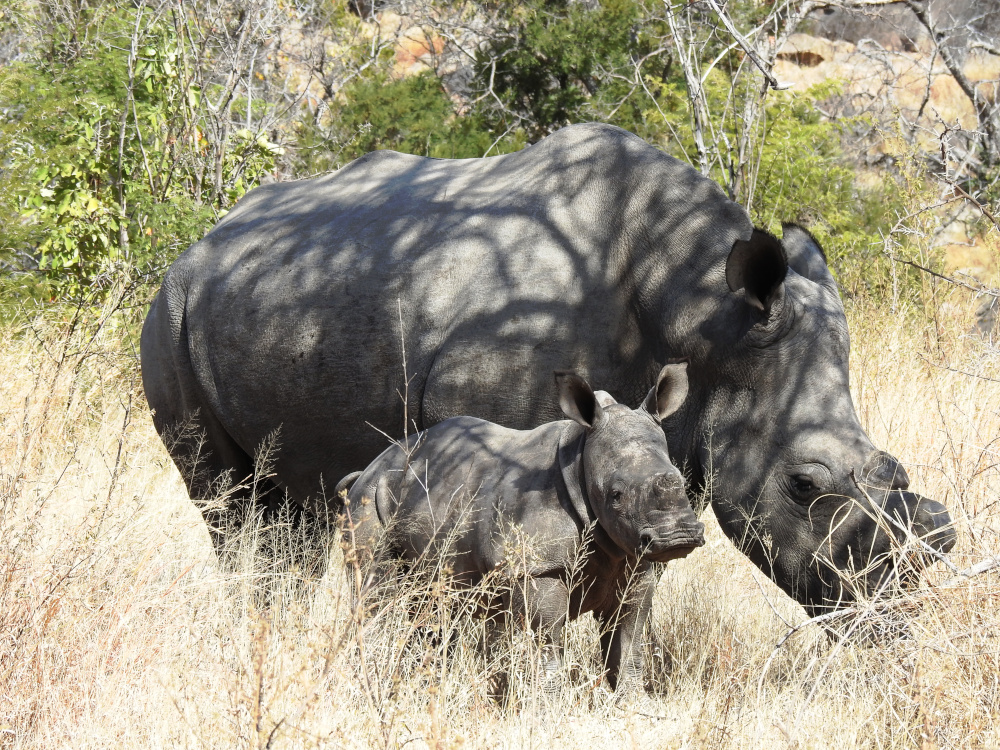

The adult rhinos in this park all have had their horns removed, which is done by the National Park to try to prevent poaching. Kurt went into great detail about the horn removal process and it basically is done to deter poachers from killing the rhinos for their horns, which can be sold on the black market for up to $100,000 per kilogram, mostly to be used for medicinal purposes in Asia (primarily China). In a few Asian cultures some people believe small amounts of rhino horns can be ingested to have effects similar to Viagra. There is no scientific evidence this works but if rhinos continue to be killed for this purpose at the current rate, they will likely be extinct in the wild within our lifetime. It is an alarming situation and a sad state of affairs that these animals have to be mutilated to save their lives from people looking to make a profit from something so unnecessary. Our guide was very passionate about his desire to save the rhino and he gave us a lot of food for thought around wildlife conservation.

After our morning visit with the rhinos we were treated to a nice picnic lunch of sandwiches, salad, and juice provided by Kurt. The rock formations and scenery in Matobo National Park are stunning and we were quite surprised that we did not see more than a couple other safari vehicles with visitors inside the park. Kurt let us know that their numbers of visitors are way down in recent years and that many former safari operators have had to shut down their businesses. This part of Zimbabwe would definitely welcome more visitors.
After lunch we went on a hike up to a cave, in which we saw amazing rock paintings on the walls of the cave done by bushmen who lived in the area some 13,000 years ago. We visited a lovely viewpoint above the cave where we took in the park’s unusual landscape and rock formations.
Next we went to the spot inside the park known as “World’s View,” which has a 360-degree panoramic view, to watch the sunset. This spot is also the chosen burial place of Cecil Rhodes and his grave marker is at the top of the mountain. The views were spectacular and we enjoyed a lovely happy hour as we watched the sun go down. I can not recommend Kurt’s company African Wanderer enough should you wish to take a safari in the Bulawayo area of Zimbabwe.
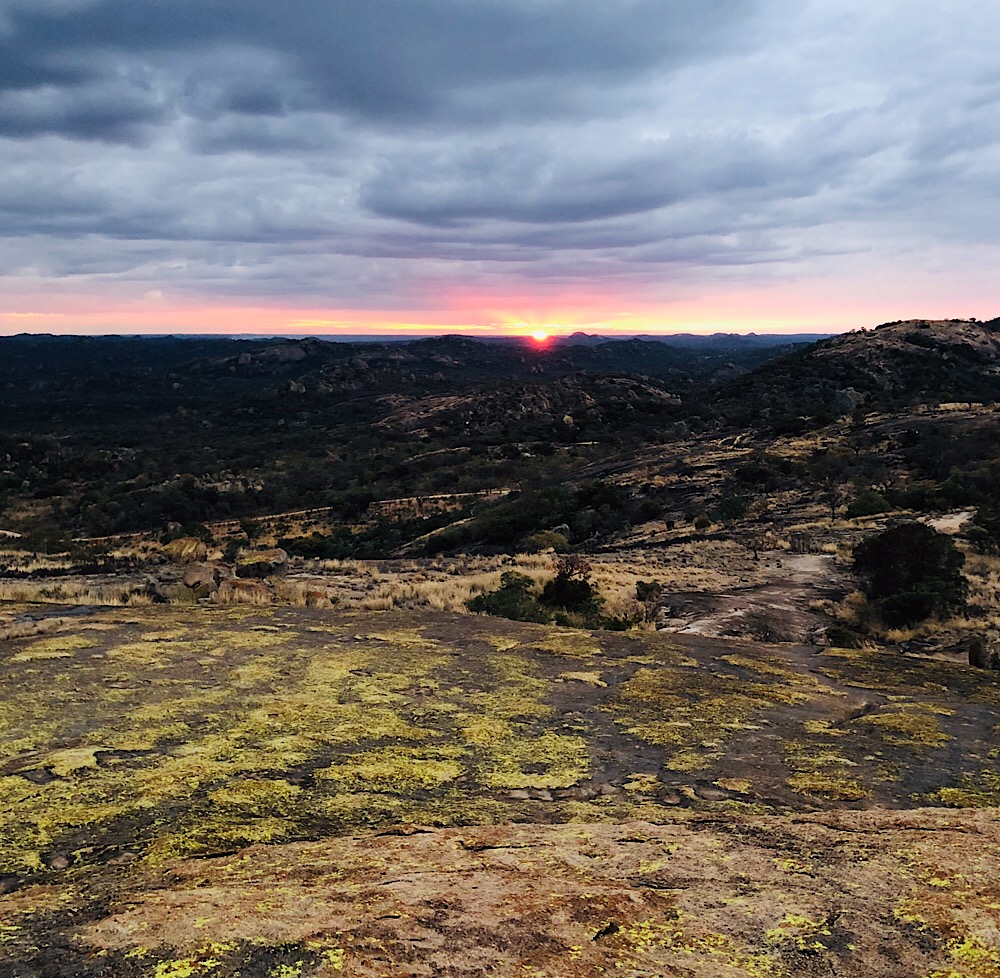
Our last stop in Zimbabwe was Victoria Falls, where we camped for our last night of the tour at the Victoria Falls Rest Camp. Our tour leader arranged for us to have a private performance by a local band performing traditional African music right at our campsite. Since this was the last official night of the tour for us and two other travelers, our group went out together for a farewell dinner in town. 42 days is a long time to be on a tour but we were sad for it to end. We will miss the great group of people who were our travel family in Africa. The Intrepid crew and four travelers in the group will be joined by some new travelers and will continue on the tour for several more weeks until they reach Cape Town, South Africa.
We booked a group of three activities known as the “adrenaline package” with Wildland Adventures in Victoria Falls. I was under the impression it would involve some zip lining and some sort of swing. When we arrived in the morning we were shown that the activities take place over the gorge beside Victoria Falls with the Zambezi River flowing far below. One activity known as the Flying Fox involved running and jumping off a platform and “flying” face down while attached to a zip line. This was pretty fun and not that scary except for the height. The next activity was the Bridge Swing and I believe that it almost gave me a heart attack. Rob and I did this one tandem so we both were attached to a long rope by harnesses and then instructed to stand on a platform high above the gorge. Then we jumped (or more accurately we were pulled off the platform) and basically free fell straight down until all the slack in the rope was gone at which point we began to swing back and forth out over the water in the gorge. Free falling from a height of around 350 feet with rocks directly below was an intense experience. I would not recommend this activity for anyone with a weak heart or fear of heights. Below is a series of photos from the Bridge Swing.


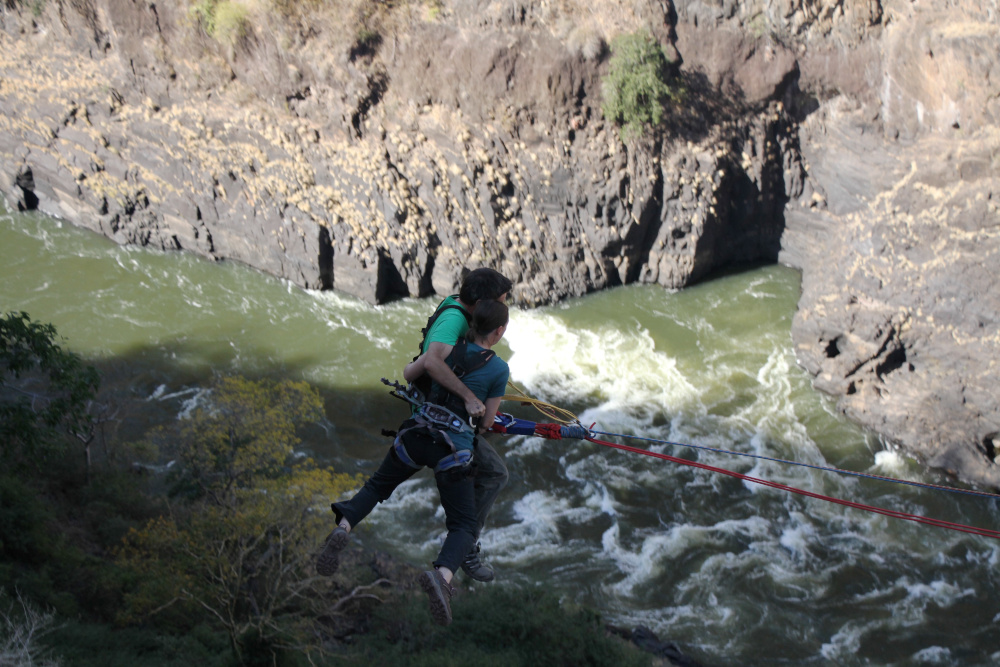
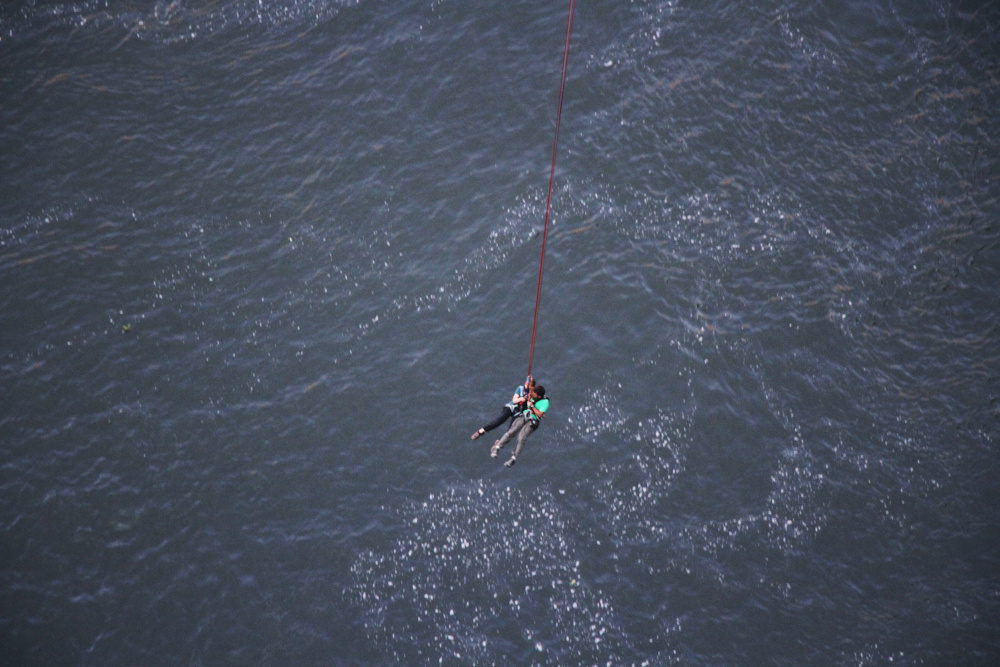
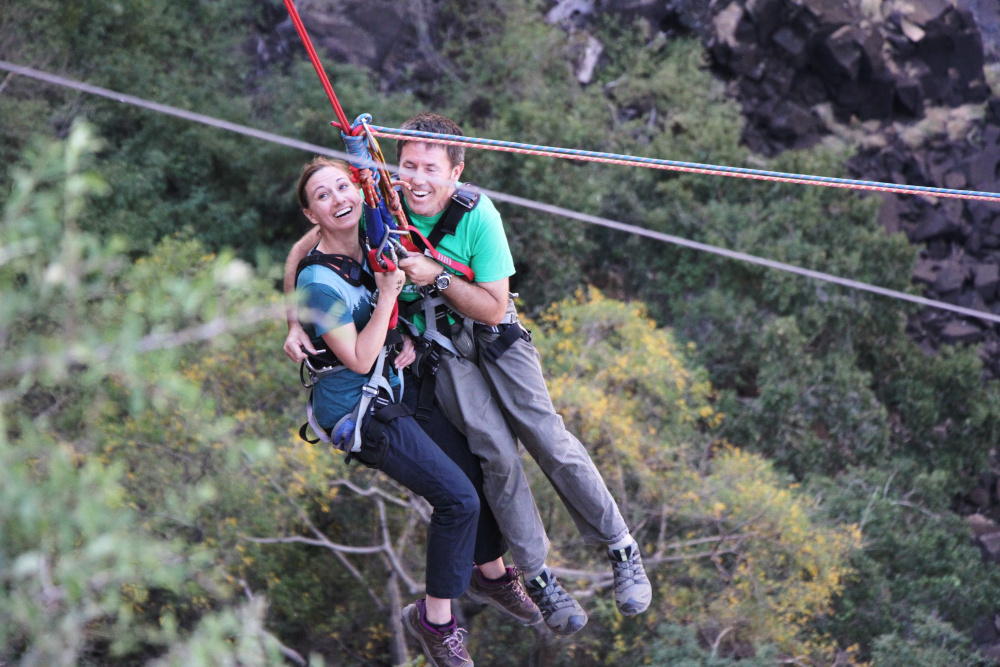
The third activity was ziplining over the gorge, which was a piece of cake and just plain fun after the Bridge Swing. I am by no means an adrenaline junky and I probably would not have agreed to do the Bridge Swing if I knew exactly what it involved ahead of time but I am glad I faced my fear and did it any way. It was the most intense feeling and perhaps the scariest thing I have ever done. Since we did it together I know that Rob was pretty scared on the free fall part of the bridge swing too but he loved every minute of it.
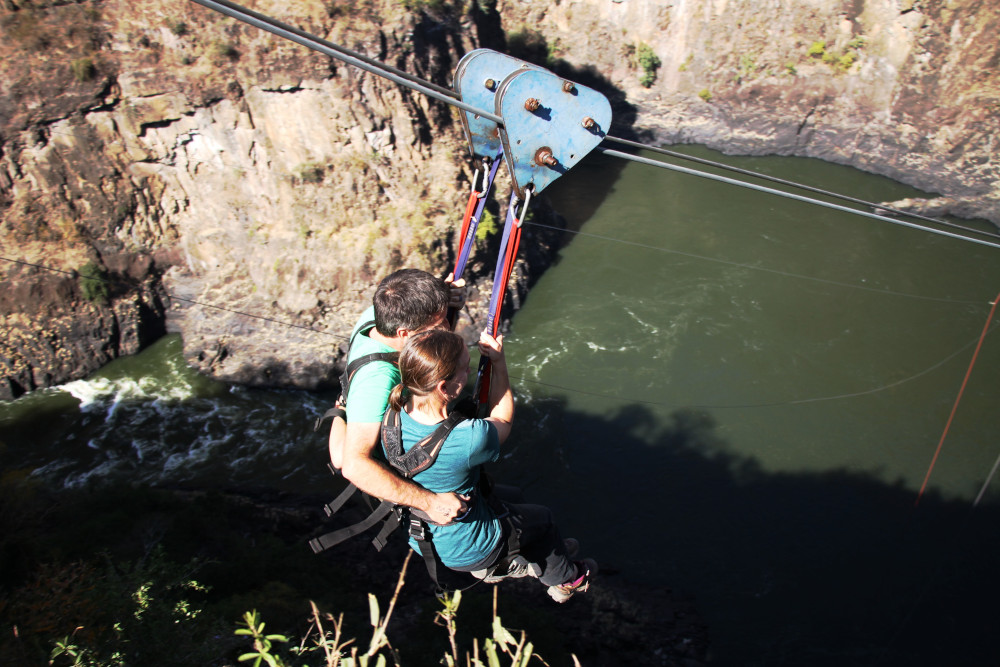
After our adrenaline filled morning we had a nice lunch then went and explored Victoria Falls State Park in the afternoon. The falls are truly a natural wonder that is split between the countries of Zambia and Zimbabwe and can be seen from both sides of the Zambezi River. You can not help but smile as you walk around and watch the magnificent waterfalls and rainbows. There are 16 view points of the falls in the park and we took our time and stopped at each one of them for a bit. The falls are a photographer’s dream and it is easy to spend several hours taking photos in the park. It was the perfect way to wrap up our time in Zimbabwe. We had no currency issues and credit cards were accepted everywhere in the Victoria Falls area since it is a major tourist destination.

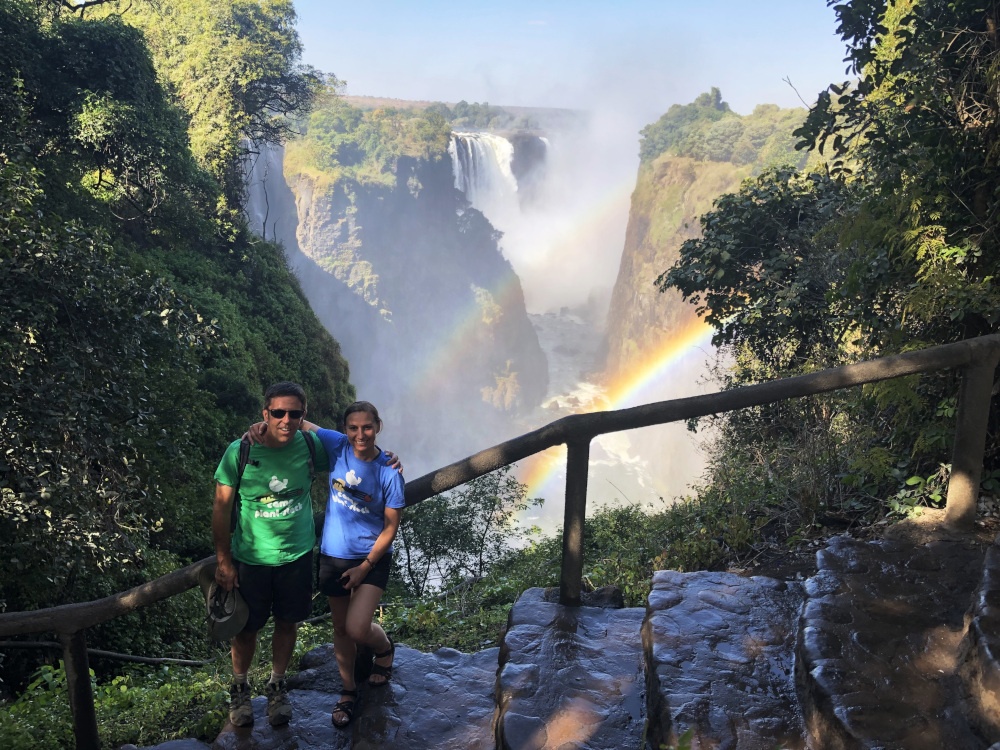
The next morning we said our final goodbyes to our fellow travelers who were still around the Vic Falls Rest Camp and took a taxi across the border to Zambia one last time to catch our flight from Livingstone airport to our next stop Johannesburg, South Africa.
